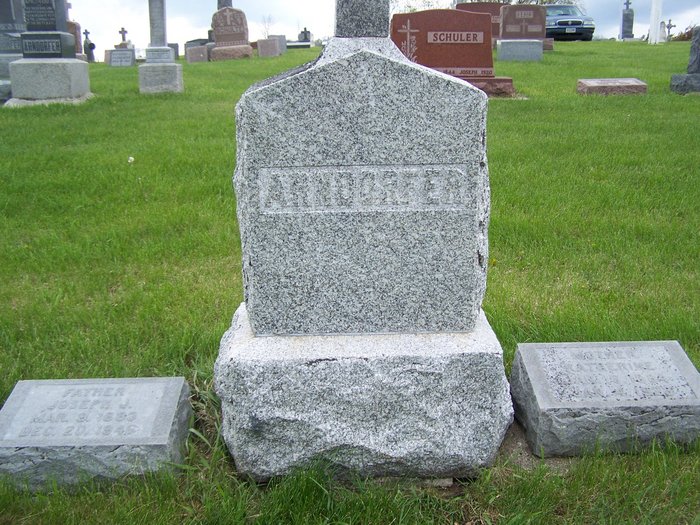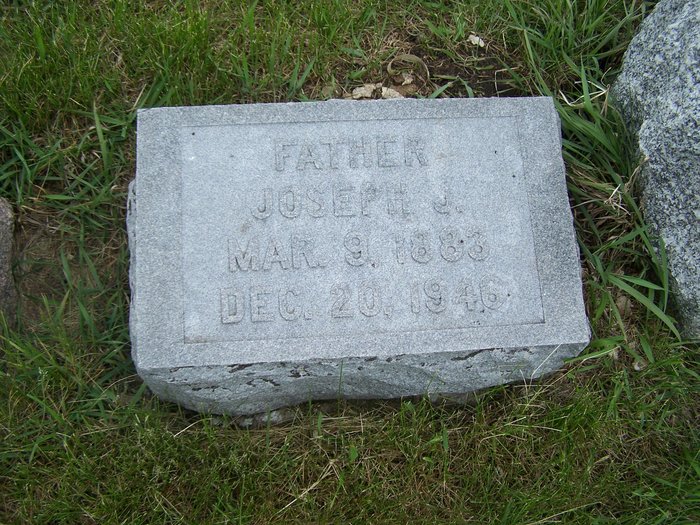Joe had been a cattle rancher, was moving a load of cattle between Hettinger and Sioux City when stricken, so was taken to a hospital in the latter place. The cause of his death was pneumonia. Joe's wife, nicknamed Katie/Katy, having died some decades before, laid near her Erdmann parents, in the St. Benedict Cemetery back in St. Benedict, Iowa, so his children buried him beside her. Some of their descendents still ranch in Adams County, by the town of Hettinger.
SOURCES: News clippings and family and local histories collected by a grandaughter of Henry J. Arndorfer(contributor #48697180
FAMILY ORIGIN: Henry was Joe's nephew. Both Henry's father, Michael J., and Joe were born in southeast Wisconsin. With many siblings, they moved well before 1900 to Iowa, along with some cousins (including the Andorfer spelling), mixed in with old neighbors (Rosenmeier/Rosenmeyer, Rahm, Froehlich, etc). This multi-family group farmed an area with St. Benedict at the center of its community life. Their farms stretched toward Irvington and Sexton to the east, Wesley to the west, and Corwith to the south. Their parents stayed back in the Beaver Dam area of Dodge County, Wisconsin. Many had been associated with St. Peter's and other nearby churches back there, and some relatives still live in Beaver Dam today. Thus, the same surnames can be found in cemeteries in both places.
The apparent father of both the Arndorfers and Andorfers, Michael Arndorfer, was widowed twice. He began in the city of Milwaukee with his sister Walburga caring for his children. One of his daughters worked in a woolen factory. They then moved to Beaver Dam.
Entering U.S. life via Milwaukee or Buffalo or some other Great Lakes port city was common for many Germans going to the Midwest. Helped by having second occupations (as one could not live by farming alone back in the old country), many worked in US cities while saving money to buy farmland. Beaver Dam is inland from Milwaukee, on Hwy. 151, halfway between the college town of Madison and the old lumber town of Fond du Lac. People settling there came to be known as timber-farmers, made a living two ways, felling trees in the frozen seasons, while farming the cleared land in the warmer seasons.
MULTIPLE SPELLINGS. Those cousins using the Andorfer spelling, with no "r", seem to be of the first Michael's first wife, so were the oldest siblings, trained in older ways. An old map for Prairie Township in Kossuth County had lettering done with old-style calligraphy, not typeset by a printer. It thus could show two farmers named Andorfer using two dots over the A, which was the way that old-country Germans denoted the "Ar" sound. The two dots were called an umlaut, and used over other vowels as well.
Thus, as US printers and typewriters replaced handwriting and thus omitted the ability to do two dots, the Andofer branch kept the original spelling, but lost its pronunciation. The Arndorfer branch did the reverse, lost the spelling, but kept the original sound, by adding an r.
Joe had been a cattle rancher, was moving a load of cattle between Hettinger and Sioux City when stricken, so was taken to a hospital in the latter place. The cause of his death was pneumonia. Joe's wife, nicknamed Katie/Katy, having died some decades before, laid near her Erdmann parents, in the St. Benedict Cemetery back in St. Benedict, Iowa, so his children buried him beside her. Some of their descendents still ranch in Adams County, by the town of Hettinger.
SOURCES: News clippings and family and local histories collected by a grandaughter of Henry J. Arndorfer(contributor #48697180
FAMILY ORIGIN: Henry was Joe's nephew. Both Henry's father, Michael J., and Joe were born in southeast Wisconsin. With many siblings, they moved well before 1900 to Iowa, along with some cousins (including the Andorfer spelling), mixed in with old neighbors (Rosenmeier/Rosenmeyer, Rahm, Froehlich, etc). This multi-family group farmed an area with St. Benedict at the center of its community life. Their farms stretched toward Irvington and Sexton to the east, Wesley to the west, and Corwith to the south. Their parents stayed back in the Beaver Dam area of Dodge County, Wisconsin. Many had been associated with St. Peter's and other nearby churches back there, and some relatives still live in Beaver Dam today. Thus, the same surnames can be found in cemeteries in both places.
The apparent father of both the Arndorfers and Andorfers, Michael Arndorfer, was widowed twice. He began in the city of Milwaukee with his sister Walburga caring for his children. One of his daughters worked in a woolen factory. They then moved to Beaver Dam.
Entering U.S. life via Milwaukee or Buffalo or some other Great Lakes port city was common for many Germans going to the Midwest. Helped by having second occupations (as one could not live by farming alone back in the old country), many worked in US cities while saving money to buy farmland. Beaver Dam is inland from Milwaukee, on Hwy. 151, halfway between the college town of Madison and the old lumber town of Fond du Lac. People settling there came to be known as timber-farmers, made a living two ways, felling trees in the frozen seasons, while farming the cleared land in the warmer seasons.
MULTIPLE SPELLINGS. Those cousins using the Andorfer spelling, with no "r", seem to be of the first Michael's first wife, so were the oldest siblings, trained in older ways. An old map for Prairie Township in Kossuth County had lettering done with old-style calligraphy, not typeset by a printer. It thus could show two farmers named Andorfer using two dots over the A, which was the way that old-country Germans denoted the "Ar" sound. The two dots were called an umlaut, and used over other vowels as well.
Thus, as US printers and typewriters replaced handwriting and thus omitted the ability to do two dots, the Andofer branch kept the original spelling, but lost its pronunciation. The Arndorfer branch did the reverse, lost the spelling, but kept the original sound, by adding an r.
Family Members
-
![]()
Catherine A "Katy" Arndorfer Greiner
1876–1959
-
![]()
Sr Mary Gabriel Josephine Arndorfer
1877–1933
-
![]()
John Martin Arndorfer
1879–1969
-
![]()
Sr Elizabeth Arndorfer
1881–1937
-
![]()
Frank Sebastian Arndorfer
1885–1953
-
![]()
Ottilia F. "Tillie" Arndorfer
1887–1978
-
![]()
William Edward Arndorfer
1889–1963
-
![]()
Verona B Arndorfer Daniel
1892–1982
-
![]()
Arthur L. "Art" Arndorfer
1894–1988
-
![]()
Raymond H. "Ray" Arndorfer
1896–1982
-
![]()
Walter Clarence Arndorfer
1905–1974
-
![]()
Helen Katherine Arndorfer Stevens
1906–1994
-
![]()
Harold Arndorfer
1908–1988
-
![]()
Marjorie Matilda Arndorfer Frank
1909–1959
-
![]()
Joseph H Arndorfer
1910–1950
-
![]()
Rose Marie "Babe" Arndorfer Parkinson
1917–2013
-
![]()
Arthur H Arndorfer
1922–1948
-
![]()
James Arndorfer
1932–1989
-
![]()
Francis Arndorfer
1935–1993
Sponsored by Ancestry
Advertisement
Explore more
Sponsored by Ancestry
Advertisement

























